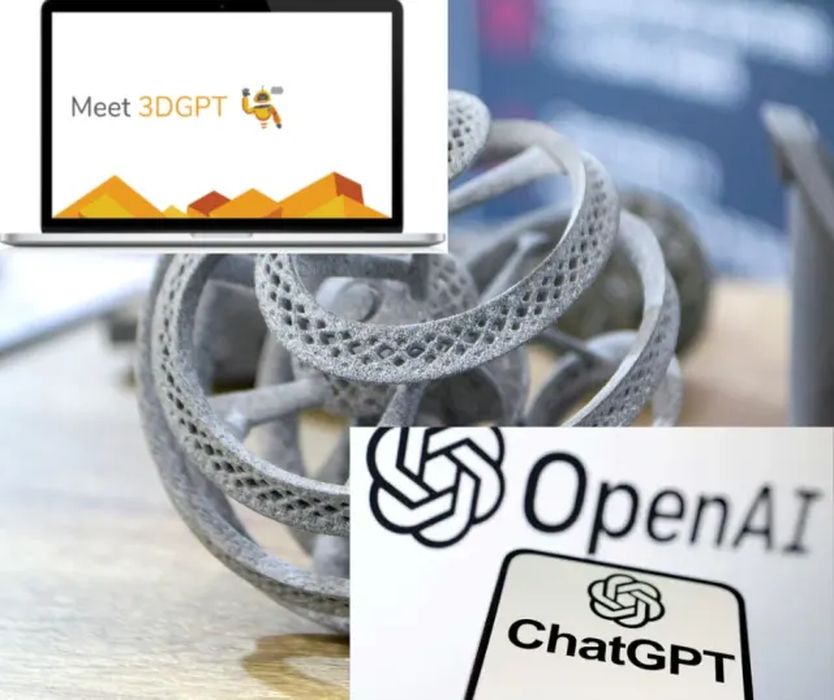
An in-depth look at how ChatGPT and other LLMs are impacting the additive manufacturing landscape.
The growth of additive manufacturing (AM) has been accompanied by incredible leaps in digital design from the likes of generative design and computational monitoring. Built-in computer intelligence platforms have been developing for some time now, with generative design creating new types of files that can only become reality through digital technologies like 3D printing.
But are these “smart” designs just the beginning?
Artificial intelligence (AI) is seemingly everywhere today, ever since OpenAI’s ChatGPT boomed onto the scene in a big way at the end of November 2022. The freely available chatbot opened large language model (LLM) access to the general public, creating new avenues to create, ideate, iterate, potentially plagiarize – and to question.
- What do we need AI for?
- _Do_we need it at all?
- How and where does AI fit into workflows under the Industry 4.0 umbrella?
- What about specifically to AM as an industry?
AI LLM Features & Flaws
AI offers incredible benefits that could save real human hours of work through automation. LLMs in particular offer virtual conversations that can be used to automate coding, generate ideas from specific prompts or quickly sort through mountains of data to target specific findings.
As with any conversationalist, though, AI is prone to inaccuracies. LLMs are prone to “hallucinations,” which are confident responses not justified by the training data. Such hallucinations underscore the precariousness of relying on AI. In such early days of widely available LLM capabilities, even the extremely thorough training and testing done to date are not nearly enough to avoid inaccuracies.
ChatGPT and similar programs are also limited in terms of timeliness: the free version of ChatGPT only has information up to 2021, for example. When it comes to fast-moving, cutting-edge industries, two-plus-year-old data may already be obsolete. Advances, discoveries, and debuts in the last two years have already moved several Industry 4.0 sectors forward, such as additive manufacturing.
AI for AM
As an advanced manufacturing technology, AM relies on software as much as hardware. Generating design files, slicing those designs, preparing print jobs, automated traceability, workflows, post-processing; every step of the AM process requires advanced software and reliable programming.
Most recently, we’ve seen manufacturing software explode with design for additive manufacturing (DfAM), such as “smart” offerings in generative design.
Generative design in software for 3D printing is nothing new. We’ve seen announcements and discussions from the likes of Autodesk, Frustum, ANSYS, MIT, Jabil, Shapeways, Dassault Systèmes, Siemens, Desktop Metal, and so many others over the past decade.
Computers can run thousands of potential design scenarios, including virtual stress testing, in the time it might take human designers to explore a few dozen options. With the added advantage of fundamentally building in the complexity of designs that could be made only by additive processes, AI in DfAM is a tantalizing proposition.
3DGPT
Turning more directly to the latest wave of LLM interest, manufacturing workflow software provider Authentise recently introduced its own AI solution specific to additive manufacturing with 3DGPT.
The release, currently more an experiment than a product per se, is freely available for interested parties to check out. Its algorithms are built upon “the power of 12,000+ additive manufacturing journal articles and standards,” as Authentise describes it.
“There are many ways we think that this tool might be useful inside our product portfolio – whether it’s to help create reliable and efficient workflows or make RFQ’s with many standards references more penetrable. Before that – we, Authentise as well as partners such as ASTM, naturally need to understand the technology’s opportunities and limits; we know that GPT algorithms sometimes hallucinate, for instance,” said Authentise CEO Andre Wegner upon the experiment’s release.
Shortly after debuting 3DGPT, Authentise followed with the introduction of Threads. This new workflow tool is supposed to integrate communication and project management tools into a new work thread collaboration suite. Threads represents a more concrete product release already backed up by reviews from early users.
“Additive is maturing,” Wegner says, about the impetus behind the 3DGPT and Threads releases. “Solving the two big problems, application identification/engineering and repeatability, demands rapid knowledge dissemination and collaboration. 3DGPT and Threads solve both. Eventually, they’ll merge – AI-supported ad hoc collaboration. But the interest in 3DGPT and the demonstrated results of Threads show that they provide individual value too!”
So, there’s a roadmap and 3DGPT is the experiment. As often happens with additive manufacturing experiments, it may not pan out. But – and here’s why it’s worth the look – it could go somewhere major.
In tandem with more immediately realizable releases like Threads as well as existing project management software, knowledgeable users able to discern AI hallucinations from peer-reviewed results could use tools like 3DGPT to advance their AM workflows.
Industry Hesitation
But even if something like 3DGPT works…what’s the point? It’s all well and good for a company like Authentise to be able to claim first-to-market on the tailwinds of the ChatGPT hullabaloo, but is it relevant for those working in the industry today?
“I reckon it will be about five years before AI can, in a meaningful way, provide reliable quality,” says industry expert Rachel Park, who has been in AM since 1997.
A conversation with Park offers a much needed step back when it comes to matters like 3DGPT. There is potential – and she has seen decades of 3D printing potential rise and soar (as well as crash and burn). Some of the 3DGPT results simply “read like regurgitation,” she notes, and “for any company that wants to stand out, [using AI] is the exact opposite of what it should be doing. If that’s what a company is relying on for their marketing content, they’re going to fail.”
Indeed, generating marketing content – especially in the midst of pretty widespread layoffs across the entire tech sector that rarely leave full marketing teams intact – seems to be low-hanging fruit for the use of LLMs in tech companies.
Copywriting offers some seemingly obvious entry into exploiting new AI capabilities and bringing them into practice. Still, if the content is indeed regurgitated, it won’t sound fresh – because it isn’t. It’s demonstrably pulled from existing resources.
Thankfully, in the case of 3DGPT, those resources are clearly designated in a “References” explainer at the end of each response section.
Others have questioned more generally the usage, relatability and reliability of a tool like 3DGPT that’s supposed to be specifically designed for AM.
“Not sure I really understand the value of a chatbot with a 3D printing skin,” says Shawn Miely, an experienced AM product and content marketer. “[I would] love to know of a use case where there is more value in this tool than with ChatGPT which, based on my few queries, seems to produce better results.”
Authentise responded directly to Miely’s remarks, explaining (with remarks cleaned up slightly):
“Fully specialized models are the future…. Experts who want real answers will need more than general platitudes or in fact complete nonsense that general LLMs often provide.
If they get really valuable to experts, specialized LLMs can also be integrated into expert systems. We’re thinking about chatbots that understand what’s going wrong with a build based on printer data and use their specialized knowledge to suggest remediation strategies.
Of course we’re still a long way from that. This is just a start – without which we can’t learn what works and what doesn’t so please rate the responses so the system gets better…”
3DGPT v. ChatGPT
So, how does 3DGPT compare to plain old ChatGPT?
Trained specifically on expert additive manufacturing materials, 3DGPT offers references – and starts with a warning:

Beneath the question entry box, Authentise further warns:
“3DGPT may generate inaccurate or offensive information that doesn’t represent Authentise’s views. Please use it at your own risk, and always check the references provided.”
ChatGPT also carries warnings and requests feedback, as should all LLMs. Machine learning has to learn to improve, so such disclaimers and feedback loops should not be surprising.
That said, I went head-to-head offering prompts to 3DGPT and ChatGPT to experience the differences and similarities between these two LLMs. The most immediately notable points are that 3DGPT offers shorter responses following prompts where AM is the assumption, as well as including DOI details for reference materials.
ChatGPT tends to be more long-winded in its responses and more AM-specificity is required in writing the prompt since the platform is so generalized. It also offers no references.
As an initial baseline, I asked each LLM to tell me what the seven 3D printing technology processes are. For reference, we turn to the ASTM-defined classifications as the gold standard—otherwise there seem to be far more than seven types of 3D printing processes out there, with some coming down to simple branding.
Read the rest of this story at ENGINEERING.com
